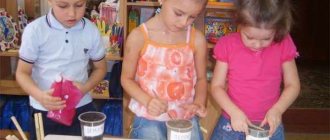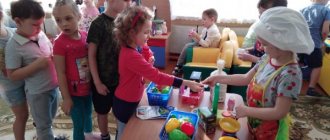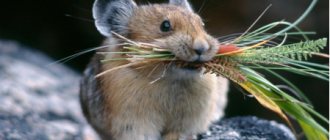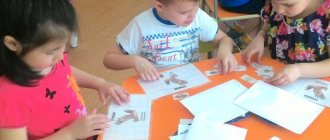PROJECT “Game educational space in preschool educational institutions”
Secondly, this is the play activity of children according to their interests, desires and choice of space, which will ensure the development of motor, mental and speech skills in preschoolers, develop the child’s creative abilities, since it will take place according to the child’s own “scenario”. During the game, the child realizes his cognitive, aesthetic and moral needs, and creates his own educational route.
This is a position to improve the quality of the educational process by creating a play space taking into account educational objectives, giving the child the opportunity to choose the type of activity, games, toys and a creative adult partner. Carrying out educational activities in forms specific to preschool children, in the form of games. The child does not need to hear the information, but to live it, i.e. play something in a role-playing game, a theatrical game, where the child figuratively participates and transforms into someone. The child needs to solve some problems assigned to him in a didactic, educational game, in a game with rules.
Novelty of the project
- this is the construction of a new pedagogical form of the educational process, variable developmental education, focused on the possibility of children’s free choice of games, materials, types of activities, participants in joint activities and communication, both with children of different ages and with adults, as well as freedom in expressing their feelings and thoughts. This is the determination of the components and principles of designing a gaming educational space, pedagogical support for an individual educational trajectory, and ensuring the personal and social success of each child.
Components of the gaming educational space of MDOBU “Medvedev kindergarten No. 4 “Romashka”
— Development of space and environment.
The design of models of educational spaces within an institution is focused on the principles of preserving the life and health of the child and the active position of the child. The content richness, transformability, and dynamism of the educational environment will be adapted to meet the needs and interests of the child himself, when he gets the opportunity to constantly feel like a full owner of toys, move freely around the kindergarten, and enjoy the life of the children and adults around him. The environment will provide playful, educational, research and creative activity, experimentation with materials; motor activity, including the development of gross and fine motor skills, participation in outdoor games and competitions; emotional well-being of children in interaction with the subject-spatial environment; opportunity for children to express themselves. This is a play space in which the child will master the objective world and the world of relationships between people through games and multidirectional activities.
Journey to the land of interesting games: a project for children of senior preschool age
Rizyapova I.I., Khabibullina V.N. Journey to the land of interesting games: a project for children of senior preschool age // Sovushka. 2022. N 4 (18). URL: https://kssovushka.ru/zhurnal/18/ (access date: 02/05/2022).
Order No. 431957
APPENDIX: Approximate game plan for the implementation of the project “Journey to the Land of Interesting Games”
Type of project : speech, cognitive and creative.
Implementation time: long-term.
Project participants: children 5-6 years old, 6-7 years old, teachers, parents of students.
Relevance of the topic:
Currently, the requirements of the educational system for the speech development of children have increased. The Federal State Educational Standard has defined as one of its objectives the development of the abilities and creative potential of each child as a subject of relationships with himself, other children, adults and the world. The comprehensive development of a preschooler can be achieved only on the basis of play activities, during which the child develops imagination and the symbolic function of consciousness, gains experience in communicating with peers, and comprehends moral values and rules of behavior in society.
In this regard, the issue of developing verbal creativity in preschool children using various methods and technologies is relevant.
Based on the above, goals and objectives were set for the development of verbal creativity of older preschoolers in the process of developing gaming technologies that stimulate verbal creativity and independence of children.
Goal: Development of speech creativity of preschool children in the process of play activities through inclusion in various types of activities, teach them to speak the Tatar language, develop dialogic and monologue speech.
Tasks.
Educational:
- to cultivate independence, initiative through the organization of play activities, positive relationships between children and adults.
- cultivate a desire to communicate in the Tatar language.
Educational:
- develop variable thinking, imagination and creative abilities, curiosity, observation, the ability to experiment, create conditions for the formation of fantasy, imagination, and creativity.
- improve all aspects of speech: achieve clear pronunciation of all sounds of the native language, expand and activate the vocabulary, continue to develop dialogical speech,
- develop interest in learning the Tatar language, promote speech understanding and the desire to speak and communicate in another language.
Educational:
- teach word creation;
- teach forms of monologue speech in the Tatar language;
- teach answering questions in a short and common form.
Project implementation principles:
- Accessibility: taking into account the age characteristics of children; adaptability of the material.
- Systematicity and consistency: gradual presentation of material from simple to complex; frequent repetition of acquired knowledge, rules and norms.
- Visual and entertaining: the proposed material must be understandable, have an entertaining beginning, be playful or have elements of a game or surprise.
- Dynamism: integration of the project into different activities.
- Supporting children's initiative in various activities.
- Taking into account the individual characteristics of each child.
- Introducing children to sociocultural norms, traditions of the family, society and state.
Stages of work on the project
Stage I – information and analytical support for the project.
- Collection and analysis of information.
- Selection and study of literature on project activities.
- Study of advanced pedagogical experience in developing children's ideas about play.
- Selection of methods for pedagogical diagnostics of pupils and parents (observation of children, individual conversations).
- Analysis of the results of pedagogical diagnostics.
Stage II - main
Scheme for implementing work experience in areas of development
| Directions of development | Types of games in joint activities of adults and children and independent activities of children |
| Social - communicative | Didactic, role-playing, nature history games. Board games, word games, bonding games, social interaction |
| Speech | Didactic games, speech games |
| Cognitive | Didactic games, word games, educational games, board and printed games, games with mathematical content |
| Artistic and aesthetic | Games - dramatization, games - dramatization, folk games, games - round dances, logorhythmics |
| Physical | Outdoor games with words, games with speech accompaniment, physical exercises, logarithmics, motor games. |
Stage III – final
Generalization of work experience.
Collaboration with parents
- Visual information: consultations “Speech development: games with the family”, “Games for the development of creative imagination”. Recommendations for parents “Game is serious”, “The world in a child’s creativity.” Publication of the pedagogical and parent newspaper “Krepysh”.
- Children and parents projects: “Creative workshop”, “Interesting games”, “Dreamers”, “Rhyme”.
- Step-by-step drawing: “You start, and I will continue.”
- Exhibitions of drawings: “Fairytale World”, “Abracadabra”, “Nonexistent Country”.
- Questionnaire: “Does your child like to fantasize?”
- Baby dictionary “Our children come up with it.”
- “Parents’ Diary or “Nechukovsky” from 2 to 5.”
- Competition of inventions: “Funny story”, “Changes”.
- Training “Sharing family experience.”
- Mailbox "Question and answer".
- A collection of ideas: “An unusual toy.”
- Family gatherings.
Expected result of project activities:
- To introduce children to the process of cognition through involving them in various types of practical and play activities.
- Develop cycles of game-activities for sections of the project, each of which would combine elements of different types of activities.
- Create a positive microsociety where each participant (adult and child) develops in the process of joint activity and co-creation.
- Increase the authority of the teacher and other preschool employees.
- Increase the pedagogical competence and activity of parents.
- Invite kindergarten teachers to participate in the implementation of the project to create comfortable conditions for the child.
- Teach children to speak the Tatar language, develop dialogic and monologue speech.
- Encourage parents to want to independently organize joint, creative games with their children at home.
Approximate game plan for the implementation of the project “Journey to the Land of Interesting Games” (Appendix).
Literature:
- Dyachenko O.M., Agayeva E.L. What doesn't happen in the world? 2001.
- Zaripova Z.M. Tatarcha sөylәshәbez // Methodology kullanma. Kazan, 2012.
- Karpova S.I., V.V. Mamaeva. Development of speech and cognitive abilities of preschoolers 4-5 years old // Creative Center. St. Petersburg, 2010.
- Kukushkina E.Yu., Samsonova L.V. Playing and learning to be friends // Teacher's Library. M.: Creative Center, 2013.
- Miklyaeva N.V. Interactive pedagogy in kindergarten // Library of the journal “Preschool Education Management”. M.: Creative Center, 2012.
- Miklyaeva N.V., Reshetilo E.A., Lopatina O.G. Play environment at home // Teacher's Library. M.: Creative Center, 2011.
- Miklyaeva N.V., Yu.N.Rodionova. Developing the abilities of preschoolers // Teacher's Library. M.: Creative Center, 2010.
- Penkova L.A., Konnova Z.P., Malysheva I.V., Perkova S.V. Development of play activity of preschoolers // Management. M.: Creative Center, 2010.
- Skorolupova O.A., Loginova L.V. Let's play?.. Let's play!!! From work experience. M., 2006.
- Shchetinina A.M. Teaching preschoolers to think // Teacher’s Library. M.: Creative Center, 2011.
Topics for creative applique projects in kindergarten
Topics for preschool students to carry out creative projects and application work:
Openwork bookmark for the ABC book Vase with fruits, branches and flowers. Cut out and paste your favorite toy. We build the kindergarten ourselves. Captain on a steamboat Red fish in the aquarium Kremlin Forest on a piece of cardboard Forest, like a painted tower New houses on our street Cucumbers and tomatoes on a plate. Autumn paintings Autumn carpet Spider on a cobweb Festive round dance Fishes in the aquarium Snow Maiden Pattern for a napkin Let's decorate a handkerchief for a doll. Floral snowflakes Flowers in a vase.
Short-term project in kindergarten for children of the preparatory group “Magazine of our group”
Nomination: projects in the preparatory group of kindergarten.
Objective of the project:
for children - make a magazine about the life of the group ;
for the teacher - to contribute to the formation in older preschoolers of the desire and ability to independently search for, collect information, and develop a sense of responsibility for the assigned task.
Project objectives:
- Development of cognitive abilities.
- Development of creative imagination.
- Development of creative thinking;
- Development of communication skills.
- Formation of prerequisites for search activity and intellectual initiative.
- Developing the ability to identify possible methods for solving a problem independently.
- Formation of the ability to apply methods that contribute to solving a given problem, using various options.
Problem:
Children become familiar with children's magazines and want to create a magazine for their group.
Project type:
- By the number of participants – collective.
- According to the contingent of participants - same age (children of the older group).
- The priority of the method is creative, practice-oriented.
- Duration: short-term (1 week).
Project plan:
Stage 1.
Conversations about children's newspapers, magazines, looking at magazines, reading articles of the children's choice.
Visiting the children's library: getting acquainted with children's magazines.
Exhibition “My Favorite Magazine”. (“My mom’s (my dad’s) favorite magazine”)
Conversation about professions: journalist, correspondent, photojournalist, editor.
Stage 2.
Discussion of options for the theme of a children's group magazine, its name, headings.
Stage 3.
Making a magazine.
Stage 4.
Presentation of the magazine for kindergarten children and parents.
Project passport.
One day I brought my favorite magazine to the group.
— Guys, do you like to read? What do you like more: reading by yourself or having someone read to you?
- I also like to read. I read not only books, but also magazines. Here is my favorite magazine “Geolenok. About everything in the world."
What do you think this magazine is about? Why do I love him? How did you guess? (according to the illustration on the cover and the title).
That's right, this magazine helps me in my work: it talks about new interesting activities, games, competitions, quizzes for children. This means that the appearance and form of the magazine speaks about its content.
— We already know what the magazine consists of. These are: cover and pages.
- What do we see on the pages? (photos, pictures, poems, text).
— What is the name of the text in the magazine? (article, report).
— And here are a few more magazines. What do you think they are about? How did you guess?
Guys, do you want to publish your own magazine?
- What could he be talking about? What articles will be in it?
(“Our favorite games”, “Our activities”, “Our holidays”, “How we walk”, “We are athletes”, “Competition of duty officers”, “We are friends with kids”, ...)
— What is needed to design a magazine page? (photos, pictures, text).
— We have photographs that do not fit into our group albums. They will be useful to us.
— What materials might we need to make a magazine? (paper, pencils, markers, glue, crayons, etc.).
- Everything you need can be found on the table.
— What will be on your magazine page? (title, text (article), photograph or picture (or both), author's name). This means you need to think about how to arrange it all on the sheet.
— And we also need to agree on how all the pages of our magazine will be arranged: vertically (portrait layout) or horizontally (landscape layout).
— I suggest you come up with a topic for your article, your report. Photos will help you with this. They will remind you of interesting events that happened in our group.
— What will the name of our magazine be?
— How can you design the cover?
— Guys, who will design the cover?
— The article you write will need to be written down. Who will record?
Options:
- we ourselves
- ask for help. Who?
— T.A. (Unfortunately, I won’t be able to help everyone. I’ll only have time to write down one article).
- contact guests, ask for help.
After the leaves are ready:
- How to combine them to make a magazine? (options discussed: hole punch, glue, stapler)
(fastened with a hole punch).
The teacher reads the articles and shows the pages of the finished magazine.
— How can we use our magazine? (show it to parents, children from other groups, leave it as a souvenir in kindergarten).
Short-term project in kindergarten for children of the preparatory group “Magazine of our group”
Nomination: projects in the preparatory group of kindergarten. Author: Tatyana Alekseevna Lukyanova Position: teacher Place of work: MBDOU “Kindergarten No. 31” Location: Sarov, Nizhny Novgorod region
Date modified: March 11, 2022 Date published: March 11, 2018



